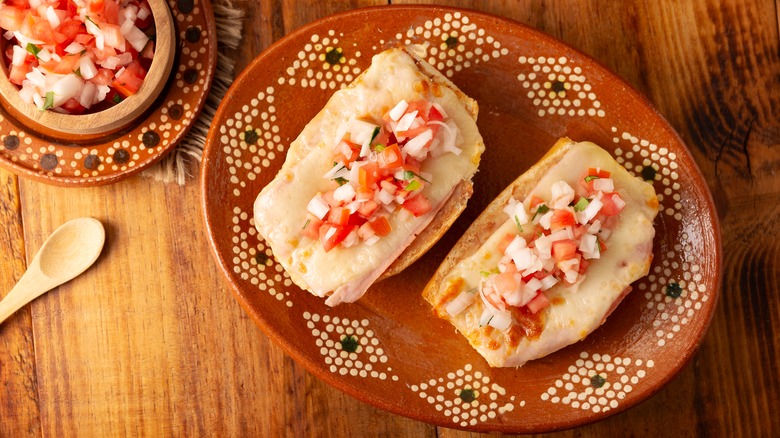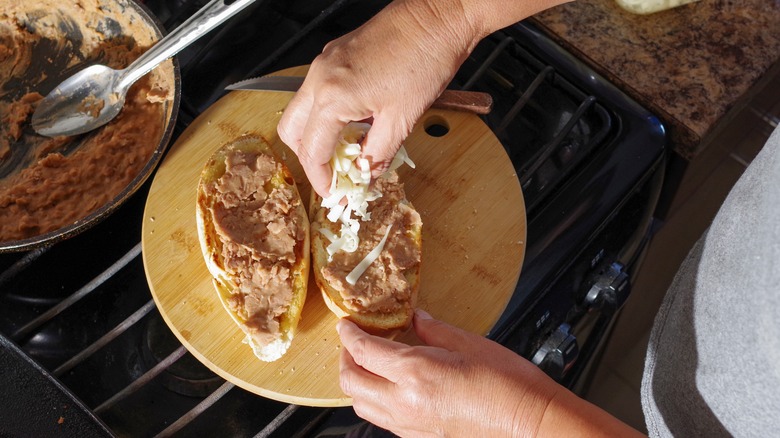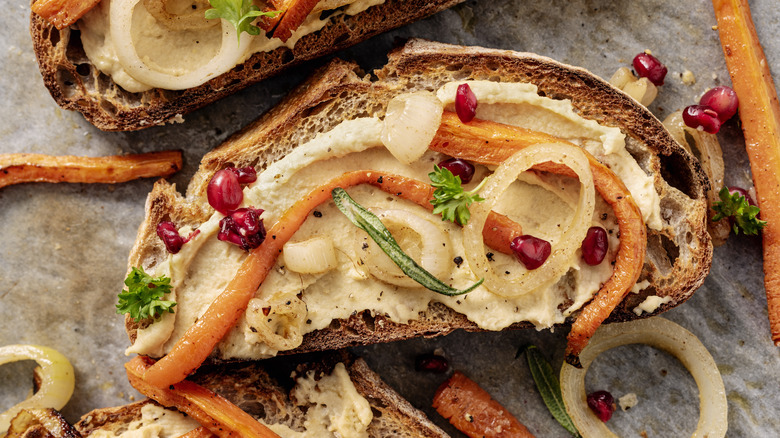Let Refried Beans Act As The Creamy Condiment On Your Next Sandwich
If you aren't already acquainted, it's time to meet the mollete, an open-faced Mexican sandwich that has the virtues of being 1) quick, 2) easy, and 3) made of common ingredients that you might already have in your kitchen. The glue that holds this thing together? Creamy refried beans, which serve as a bridge between toasty bread beneath and melty cheese on top — like a quesadilla if it were open-faced and built on bread, or a pizza with beans in place of tomato sauce. There's lots of room here for add-ons, but that's the basic gist, and it's plenty comforting.
Comfort is the point of the mollete. Like another Mexican breakfast staple, chilaquiles, this is a dish often consumed in the first part of the day, but not always: It's something folks reach for whenever they're seeking something hearty and soothing. Unlike chilaquiles, the mollete relies on bread rather than tortillas. Compared to the corn tortilla, bread is a relatively recent addition to the Central American diet, with wheat flour introduced by European colonizers only in the 16th century. That gave way to a couple now-common Mexican breads: bolillos, which are longer rolls that taper at the ends like baguettes, and teleras, which are rounder and more pillowy. In the mollete, either kind can provide a sturdy platform for refried beans, whose rich creaminess contrasts with the warm crunch of the bread. The mollete also raises an important question: Why aren't we putting beans on sandwiches more often?
How to make a mollete
If you don't have bolillos or teleras on hand, don't sweat it — folks have also been known to use baguettes, Portuguese rolls, or even soft loaves from the grocery store. Remember, the point is convenience. Whatever bread you use, slice it down the middle the long way. Spread each open half with some warmed refried beans, either homemade or (no shame in it!) from a can. Sprinkle the beans with a generous layer of a cheese that melts well — salty Oaxaca cheese is a popular choice, but mozzarella or pepper jack are also great. Then put these open-faced sandwiches on a sheet pan and stick them in a 350-degree oven for up to 10 minutes — until the cheese melts and you see the bread start to brown around the edges (this would also be a fine recipe to make in your toaster oven).
And there you have it: a three-ingredient recipe that's appropriate for any time of day. But if you want to go beyond the three ingredients, you're free to decorate your mollete however you like. In Mexico, the sandwiches often come with fresh pico de gallo on the side, though another salsa would do if that's what you've got in your fridge. Other options include pickled jalapeños, sliced avocado, chopped cilantro, and lime wedges.
Are creamy beans an underrated sandwich spread?
In Mexico, refried beans aren't just a key component of the mollete. You'll find them on various other types of tortas, like the torta ahogada, a sandwich filled with beans and carnitas then drowned (that's what "ahogada" means) in spicy salsa. There's a pretty strong argument to be made for putting mashed or pureed beans on more sandwiches: They're exceptionally good for you, rich in protein and fiber. As a source of protein, they're much better for the planet than meat, a more typical sandwich filling. And creamy beans play a structural role in a sandwich, as well, providing an anchor for other ingredients and helping the whole thing stick together.
So why not use creamy beans as a condiment on all sorts of sandwiches? Hummus, aka pureed chickpeas, is another likely contender — here's our secret to the silkiest hummus you can make at home. Whether you're using homemade or store-bought, though, you can't really go wrong by spooning some into a toasted pita, then adding greens, pickled veg, and/or nuggets of falafel or roasted chicken. White bean spread would go perfectly on herby focaccia, maybe with a sliced summer tomato or two. You could mash up some spicy red beans and spread them on a bun with sausage. As the mollete shows, beans don't have to be a side dish, an afterthought, or a supporting actor — they can play the starring role.


